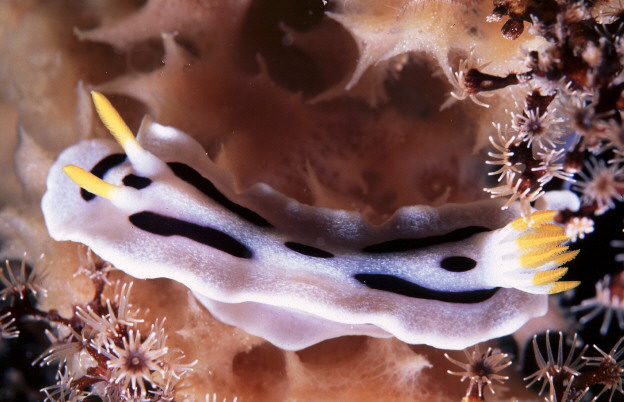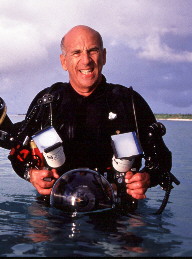
| Chromodoris dianae Photo courtesy of Steve Drogin Tulamben, Bali, Indonesia Oct., 1997 |
Chromodoris dianae Gosliner & Behrens, 1998
Well, this is the last of the five new chromodorids described in Gosliner & Behrens 1998, and certainly the most important for me as the name is in recognition of my wife, Diana , who has tolerated beyond imagination, my desires to work with my colleagues on this group of marine critters, taking many hours of valuable time away from family and friends.
The decision to name a species after your wife, is one that a researcher should not make lightly. The upsides are obvious and come with little risk, and maybe a hug and a kiss, but you must consider the possible down sides as well. First of all we aren't talking about naming a lovely orchid or new hybrid of a rose after your most significant, we're talking about naming a slug. Get real. Naming a slug after your wife, are you crazy? History now has spoken. Well with that said, the most important consideration, in my mind, is - Does the critter have similar attributes to those that drew you to ones spouse in the first place? Is this critter beautiful enough, humble enough, impressive enough, classy enough, enough, enough. In this instance I believe, and now Diana concurs that Chromodoris dianae, is all those things.
One of the most common species of chromodorid observed last year in the Philippines and Sipadan Islands, we have referred to it for years simply as Chromodoris "powder blue." The powdery blue color of the mantle is hard to describe because no blue pigment really exists, but in fact is created due to a fine encrustation of white over blue internal body color. The light blue and white snow flack appearance, give the nudibranch a "Sleeping Beauty" - winter scene feeling. The gills and rhinophores are tipped in orange, and a few specimens had small patches of orange distributed along the edge of the margin. Chromodoris dianae has caught the eye of several photographers who have included fantastic shots of this species in their books and on their web sites. These include Michael Wong's photo in Sipadan - Borneo's Underwater Paradise (p. 103), Allen & Steene's, Indo-Pacific Field Guide (p. 198), and Colin & Arneson's Tropical Pacific Invertebrates (figs. 852 & 856). These photos, as well as Steve's shown above, show the variation in the black dorsal marking that occurs in this species. While a great deal of variation exists, there is a common theme in the discontinuous black submarginal band and the oval black spots that occur along the midline of the notum. The submarginal band may be nearly entire except in areas adjacent and lateral to the rhinophores or may be a series of spots and dashes. The width and shape of this band is also variable. Towards the middle of the animal, the band may occur closer to the midline. All specimens have a spot or line between the rhinophores. Posteriorly, the two black submarginal bands may meet behind the gills or may be interrupted with a medial black spot posterior to the gills. In some specimens long oval spots form an hourglass pattern in the center of the dorsum.
Internally, characteristics of the reproductive system and radula, and well as its interesting distribution and shape of the subcutaneous mantle glands, differentiate this species from other similarly pale blue colored species, such as Chromodoris lochi, C. willani and C. boucheti. In both, Chromodoris lochi and willani the dark dorsal lines are long and continuous, and C. willani has conspicuous white specks on the gills and rhinophores.
Known for years from the Philippines, Borneo and Indonesia, it is common in relatively shallow waters on reef walls and drop-offs, 10-30 meters deep. While not unusual to see several specimens in a single dive, we have not determined its association with a particular sponge prey, having observed it on many substrates, day and night.
Was the risk worth it? I think so. Is Chromodoris dianae a species fitting the recognition of ones wife? There is no question in my mind!
Photo courtesy of James D. Watt
Kona, Hawaii

Steve is a 58 year old amateur Diver/Photographer who spends full time traveling and diving the globe. He lives in La Jolla, California and is a member of the San Diego Underwater Photographic Society. His photographic credits include a recent article on the sunken fleet of Bikini Atoll in Sports Divers Journal(Issue 16) . Steve's photographic credits also include several great branch shots on past BOW's on this site. If you like what you see, drop steve a note! Send Steve mail at sbdrogin@mill.net |
Taxonomic information courtesy of:

David W. Behrens
Author:
Pacific Coast Nudibranchs
Send Dave mail at seachalleng@earthlink.net
|
